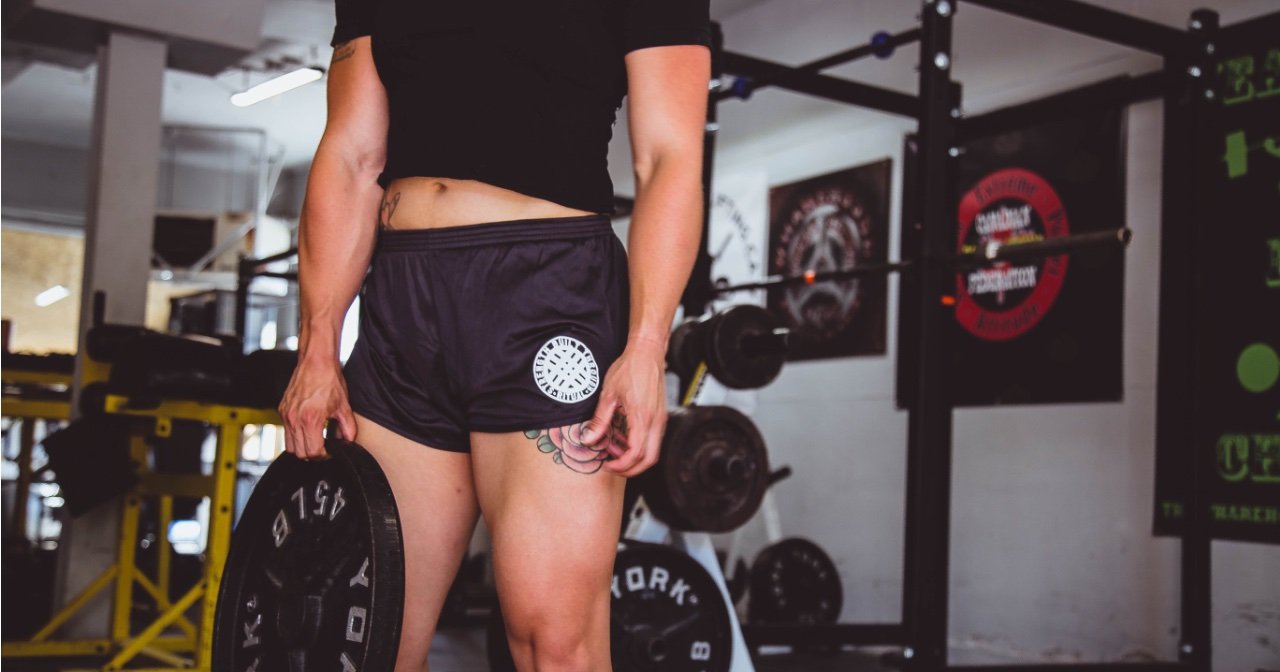Listen on: Apple Podcasts | Spotify
Muscle plays a significant role in your long-term health, fitness, longevity, and even your ability to ward off disease and infection.
Yet the vast majority of Americans do little to no strength training.
Investing three to five hours per week, lifting weights and doing other movements that challenge your muscles, bones, and connective tissue is one of the healthiest activities you could take part in.
Provided people follow a well-designed strength training program, the benefits of muscle mass go way beyond aesthetics.
1. Muscle builds your quality-of-life savings account.
Muscle is your quality-of-life savings account. The more you have as you enter later adulthood, the longer you’ll be able to carry on the activities you love to do today.
Without consistently putting your muscles under sufficient stress, they get smaller. It would be like hoping you build a big financial nest egg, but never put any money into your retirement account. To build the next egg, you have to exercise discipline with your spending, and set money aside.
To build a quality-of-life savings account with muscle, you have to…well…exercise.
Throughout your life, you’ll face injuries and physical setbacks that keep you from exercising. You might also get cancer, or develop heart disease, which causes cachexia. The more you have when that happens, the more you can afford to lose before facing serious health problems.
Muscle mass is an independent predictor of all-cause mortality in older adults. The more muscle mass you have, the lower your risk of dying.
Read also: How much protein do I need to build muscle?
2. Muscle mass increases your carbohydrate capacity.
The only places you store carbohydrates are in your liver and skeletal muscle. You’re not going to increase your liver’s size, so building muscle is the only way to improve your carbohydrate capacity.
If you have diabetes or insulin resistance, talk to your doctor about following a ketogenic diet for a while. If your doctor says a ketogenic diet doesn’t help with diabetes, find a different doctor. But even with a change in diet, it’s imperative to start strength training.
Type II diabetes and muscle loss create a vicious cycle. The more muscle you lose, the more likely it is that you’ll develop type II diabetes. The worse your type II diabetes gets, the faster you lose muscle.
As muscle is the main organ of glucose disposal, reduced muscle mass leads to increased insulin resistance. Conversely, insulin resistance or T2DM (type II diabetes) itself is associated with accelerating loss of skeletal muscle, causing a bidirectional positive feedback loop between metabolic disorders and sarcopenia.
Kim JA, et al.
Though most people with type II diabetes are also overweight, about 20% of those with the condition are at a normal weight. A lack of muscle, whether you’re overweight or not, is a significant factor in type II diabetes risk.
3. Resistance training improves heart health.
Strength training depletes oxygen in the blood. In the absence of oxygen, your contracting muscles produce lactate. Lactate causes your muscles to burn.
Your heart beats harder and faster to take the lactate away from and deliver more oxygen to your working muscles.
With continued strength training sessions, your stroke volume improves and your resting heart rate drops, which means your heart becomes more efficient.
Research also shows that resistance training improves the health of your blood vessels.
Strength training provides cardiovascular benefits similar to endurance training without the negative impact of increased inflammation, overuse injuries, elevated cortisol, or reduced testosterone.
4. Weight training increases bone density.
According to the National Osteoporosis Foundation:
- A woman’s risk of fracture is equal to her combined risk of getting breast, uterine, and ovarian cancer
- Men are more likely to break a bone due to osteoporosis than to get prostate cancer
- A quarter of 50+ year old hip fracture patients die within a year of the fracture
- Six months after a hip fracture, only 15% of patients can walk across a room without assistance
Dense bones support your weight when you jump, trip, or slip on the ice. The lower your bone density, the more likely it is that you’ll break something.
Your body needs macro and micronutrients such as magnesium, vitamins D and K, calcium, and protein, which provide the raw materials to build bone.
However, your body only uses your macro and micronutrients if you give it a reason. The stress from strength training provides that reason.
5. Resistance training improves coordination and reduces joint pain.
Too much sitting, and you lose your ability to move correctly.
Eventually, you can’t squat properly and need to hang onto a toilet just to sit on it without losing your balance. Or you need to take a painkiller to deal with your back pain after carrying your groceries into your home.
A simple squat that a four-year-old can do flawlessly becomes a painfully awkward movement for someone who’s spent years sitting too much and moving too little.
When you can’t move right, you’re more prone to falling. And if you’re among the many who lack bone density, when you fall, you break.
No matter your age, you can regain a significant amount of coordination and movement proficiency.
One of the main reasons people experience lower back pain, knee pain, and hip pain is that they don’t have a balance of functioning muscle.
For example, if you don’t squat, lunge, and do other movements to strengthen your glutes, it leads to tension in the hips, hip flexors, lower back, and even in the upper back.
Weak glutes also lead to knee pain, because your quads, the front of your thighs, have to do all the work in moving you around.
Ironically, “bad knees” are the number one excuse not to strength train, which is the solution to minimizing the knee pain.
A loss of muscle throughout the back leads to shoulder pain, neck pain, and headaches, too.
6. Strength training improves mobility.
Flexibility is a measure of how far you can move through a range of motion. Mobility is how far you can move through a range of motion with a sense of muscular control over it.
When you follow a well-designed weight training program and use good technique, you move your muscles, under tension, through a full range of motion.
As your strength improves, your nervous system allows you to move through a greater range of motion under tension.
Eventually, you gain flexibility and the ability to control your body as you move through a greater range of motion.
That’s important for sports, but also for everyday movement, from grabbing stuff out of the trunk of your car, to wrestling with your grandchildren.
Read also: Why are my muscles so tight?
7. Weight training improves body composition.
Weight training is way more potent for minimizing your muffin top, beer belly, saddlebags, and double chin than spending hours each week on a treadmill, stepmill, or elliptical.
Why?
Dropping body fat isn’t just about accumulating calorie counts on a treadmill dashboard like a pinball machine. It’s about changing the way your body uses the food you eat, and modifying the way your metabolism works, even while at rest.
Strength training stimulates testosterone and growth hormone production, helps you lower chronically high cortisol levels, improves your capacity for storing carbohydrates, and helps you displace the fat on your arms and legs with dense, firm muscle.
Resistance training leads to lower body fat levels; research shows it specifically helps lower belly fat or visceral fat. Visceral fat increases inflammation and your risk of heart disease.
Unless someone competes in a physique competition, where they need ultra-low levels of body fat for a short time, there’s little value in using cardio to keep body fat levels in check.
You get more bang for your buck with strength training. And let’s face it, we all feel better when our clothes hug us in the shoulders instead of our love handles.
All that said, if you had to choose between less muscle and less body fat or more muscle and more body fat, more and more research shows you’re better off with more muscle and a little more body fat.
Read also: Strength Training Stimulates Fat Loss: Here’s How.
8. Resistance training builds your resilience to stress.
Strength training is stress. To progress, you have to recover from that stress and face slightly more challenging stress the next time.
Over the months, and even years, you increase your capacity for physical and mental stress, and train your body to bounce back from higher stress levels than before.
More than ever, people have anxiety about almost everything. They believe they’re victims of everyone around them. They mistake normal challenges of adulthood for “struggle.”
We need to learn how to handle stress with a little “suckituptitude” rather than avoid it.
Weight training can do that.
9. Muscle mass directly impacts your immune system strength.
I included this quote in my article on habits for a strong immune system, and it’s worth including here again:
Skeletal muscle regulates immune system functions via myokine signaling and the expression of immune modulatory surface molecules. Immune cells in turn critically influence muscle mass and function. Therefore, skeletal muscle may act as a central integrator between sarcopenia and immune senescence (age-related loss of immune function).
Nelke C, et al.
To be blunt, I’m disgusted by the incessant attention on masks and social distancing to reduce the spread of COVID-19 cases, and the complete lack of attention on how we can prepare our bodies to defend themselves against the virus.
Our public health policy-makers and politicians are acting irresponsibly by not addressing the nutrition and lifestyle factors that are critical to maintaining health when faced with this, or any other pathogen.
Your level of muscle mass directly impacts your immune system strength. As I recently posted on my Facebook profile:
If hospitals are essential for curing COVID, health clubs are essential for preventing it.
#IMmuneSTRONG
Summary
This is one of my favorite personal development quotes:
If you do the things you need to do when you need to do them, then someday you can do the things you want do when you want to do them.
John C Maxwell
That couldn’t be more accurate when it comes to strength training. If you don’t put in the time and effort today, you’ll wish you had one day.
Don’t take the chance of missing out on opportunities in the future because you made an excuse not to strength train today.
The long-term effects of muscle and bone loss, poor posture, uncontrolled blood sugar, and excess body fat eventually leave a mark that leads to a need for medication and a lower quality-of-life.
There’s a lot you can’t control in life, and exercising is no guarantee you won’t face something extreme and unexpected.
However, if you consistently follow an excellent strength training program, you dramatically increase the odds of a much higher quality-of-life for years, even decades to come.

Feel Better Fast. Guaranteed.
Energy+, EDGE, and MentaBiotics make up the Happy Juice supplement stack, with ingredients clinically proven to:
- decrease anxiousness scores by 55%
- decrease irritability scores by 60%
- decrease fatigue by 64%
- decrease anger 54%
- decrease tension by 45%
- decrease confusion by 43%
- decrease overall distress by 49%
- increase good bacteria by 70%
- decrease negative mood by 105%
- increase positive mood by 211%



